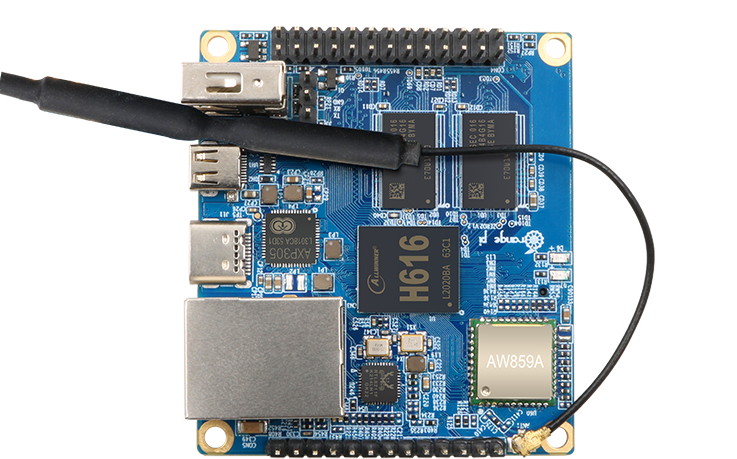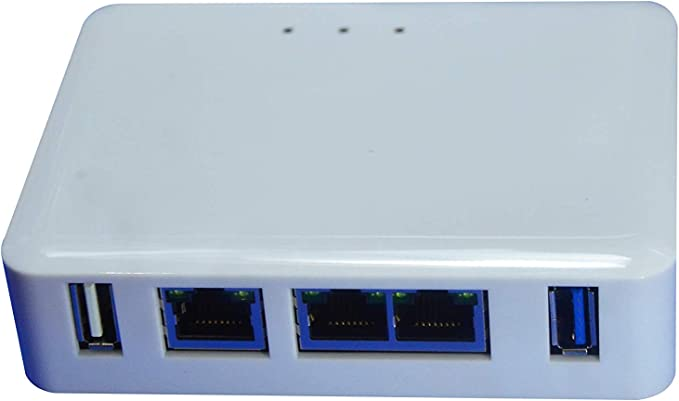RPi Alternative: Orange Pi Zero 2 (1GB)
-
I tried an Orange Pi Zero 2 1GB, purchased from Amazon for $36.00; in-stock and arrived the next day.
It uses an Allwinner H616 processor (quad core Cortex-A53 like RPi 3B+; clock speed not stated in specs but is reported elsewhere to be 1.5Ghz), has 1GB DDR3 RAM on board, MicroSDHC slot, gigabit Ethernet, WiFi (a/b/g/n/ac), BT, USB C, three USB 2.0 ports (one connector, two via pin header), and more.
Although Orange Pi calls this board "Zero", it is a very different form factor from the Raspberry Pi Zero/Zero 2 boards. The Orange Pi Zero 2 is 60mm x 52mm (2-3/8 x 2 inches), which is closer to two Raspberry Pi Zero 2 boards placed side-by-side, or about 2/3 the length of a full Raspberry Pi 4B. Power (5VDC/2A) is delivered to the board either by the USB C connector, or by connecting to either of the pin headers (the 13-pin header seems safest to identify the correct pins). If you decide to use the serial console/debug port, you'll need a USB-TTL adapter that is 3.3V (not 5V) compatible. There is an expansion card available for the 13-pin header to neatly add two USB 2.0 ports and the IR receiver (you can add these yourself with parts of your own sourcing as well). The 26-pin header is compatible with the 26-pin form of the Raspberry Pi GPIO header, but since it's not the 40-pin form, may not work with some HATs available for the genuine RPi. The included dual-band WiFi antenna connects to the board using the common U.FL connector, so it's easy to find and use an alternate antenna.
I started out downloading the available Ubuntu image (Jammy server) and writing it to a MicroSD card using my usual method:
dd. This, however, failed to produce a valid filesystem on partition 1 of the card, and after two failed attempts, I used the Orange Pi-recommended method of using Win32DiskImager, which immediately produced a valid filesystem. I plan to investigate the reasons for this difference later, but for the moment, it's sufficient to say that following their instructions worked (i.e. reasonable expectation met). The Orange Pi then booted immediately from the MicroSD card with SSH configured and running, so I never had to connect a monitor and keyboard. I was able to log in using the default credentials (userorangepipasswordorangepi). I updated all OS packages, installed nodejs v18.12.1 and Reactor, and started Reactor with no problems. I went on to install mosquitto and then took a measurement of system memory utilization: 31%.Orange Pi's startup documentation is very good and I didn't find any errors or big gaps in my straight-line shot to get it working (once I decided to follow them
 ). In addition, they have a lot of additional documentation in PDF form you can download, including full schematics and detailed mechanical diagrams.
). In addition, they have a lot of additional documentation in PDF form you can download, including full schematics and detailed mechanical diagrams.Orange Pi offers an add-on board with a battery-backed real-time clock (RTC). I have always maintained that any "serious" home automation gateway/hub requires a battery-backed clock so it can boot up with the correct time even when Internet access is not available. Therefore, I recommend this add-on module, which connects directly to the 26-pin header on the board.
For price, availability, ease of startup, and documentation and support, I can recommend the Orange Pi Zero 2 1GB as a viable Raspberry Pi alternative, keeping in mind it is more in line performance-wise with the RPi 3B+ and Libre "Le Potato" than the current 4B.
Up next: Orange Pi 4 LTS
Edit: I want to add, although the price of the RPi Zero 2 W is very attractive at MSRP US$15 (if you can find one), it has half the RAM of this board, only single-band (2.4GHz) WiFi, fixed on-board antenna, and no Ethernet. Out of the box, you have to connect a monitor (with a special cable -- mini HDMI) and keyboard to the RPi to configure WiFi and enable SSH before you can start using it, where the Orange Pi comes up with SSH running and the system accessible via Ethernet. Although the Orange Pi Zero 2 is more than twice the price of the RPi Zero 2 W, the cost in the absolute is still so low and those differences so valuable that I'm thinking it's well worth it in any application where the small form factor of the RPi Zero isn't the driving requirement.
-
Passmark Performance Test Results:
OrangePi Zero2 Cortex-A53 (aarch64) 4 cores @ 1512 MHz | 984 MiB RAM Number of Processes: 4 | Test Iterations: 1 | Test Duration: Medium -------------------------------------------------------------------------- CPU Mark: 453 Integer Math 10026 Million Operations/s Floating Point Math 1397 Million Operations/s Prime Numbers 2.7 Million Primes/s Sorting 2054 Thousand Strings/s Encryption 131 MB/s Compression 3117 KB/s CPU Single Threaded 214 Million Operations/s Physics 49.2 Frames/s Extended Instructions (NEON) 186 Million Matrices/s Memory Mark: 328 Database Operations 234 Thousand Operations/s Memory Read Cached 2701 MB/s Memory Read Uncached 1712 MB/s Memory Write 3691 MB/s Available RAM 844 Megabytes Memory Latency 169 Nanoseconds Memory Threaded 1832 MB/s --------------------------------------------------------------------------The system averaged just under 15MB/s storage write speed using a Samsung 32GB class 10 MicroSD card. If high-rate disk I/O is typical of your application, you may consider using a system with on-board eMMC, or that offers an alternate interface (PCIe/SATA/NVMe).
-
 T toggledbits referenced this topic on
T toggledbits referenced this topic on
-
 T toggledbits referenced this topic on
T toggledbits referenced this topic on


